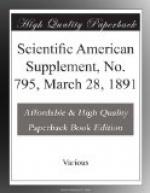DRESSED WEIGHT, INTERNAL ORGANS, ETC. ____________________________________________________________
________ | | | Hens. | Chickens. |___________________|____________________ | | | | | Lot I. | Lot II. | Lot I. | Lot II. | Nitro- | Carbon- | Nitro- | Carbon- | genous. | aceous. | genous. | aceous. |_________|_________|_________|__________ | lb. | lb. | lb. | lb. Live weight. | 21.31 | 22.0 | 17.89 | 12.63 Dressed weight. | 14.86 | 15.09 | 12.01 | 8.89 " " per cent. | 69.7 | 68.6 | 67.1 | 70.5 Weight of blood. | 0.75 | 0.66 | 0.55 | 0.34 " " feathers. | 1.41 | 1.25 | 1.28 | 0.66 " " intestinal fat. | 0.59 | 1.98 | 0.34 | 0.66 " " offal. | 3.70 | 3.02 | 3.62 | 2.08 " " bones. | 3.47 | 3.63 | 3.18 | 2.69 " " flesh. | 11.39 | 11.47 | 8.93 | 6.20 ___________________________|________________________________
_________
The breaking strain of the right tibia was as follows for the hens and chickens of the various lots:
Average hens, nitrogenous. 48.16 " " carbonaceous. 51.74 " chickens, nitrogenous. 46.64 " " carbonaceous. 31.18
There was little difference in the strength of the bones of the hens, undoubtedly because the bones were mature before the feeding began, and were little affected by the feeding. We find, however, that the bones of the chickens fed on nitrogenous food were almost fifty per cent. (49.6) stronger than those fed carbonaceous food.
The difference in the composition of the flesh, as shown by the analysis of Mr. W.P. Cutter, is given below:
_______________________________________________________
___________ | | | Hens. | Chickens. |___________________|____________________ | | | | | Lot I. | Lot II. | Lot I. | Lot II. | Nitro- | Carbon- | Nitro- | Carbon- | genous. | aceous. | genous. | aceous. |_________|_________|_________|__________ Albuminoids. | 43.81 | 25.13 | 52.00 | 30.06 Fat. | 12.59 | 20.76 | 5.54 | 11.34 ____________________________________________________________
_____
The flesh of each group was submitted to a number of persons for a cooking test, and the almost unanimous verdict was that the flesh of the fowls fed a nitrogenous ration was darker colored, more succulent, more tender, and better flavored, though on this last there was some difference of opinion.
CONCLUSIONS.
So far as it is warrantable to draw any conclusions from a single experiment of this kind, it would seem that:
Chickens fed on an exclusive corn diet will not make a satisfactory development, particularly of feathers.




